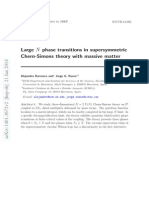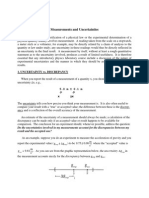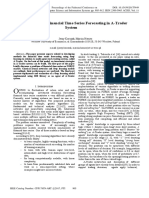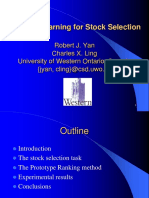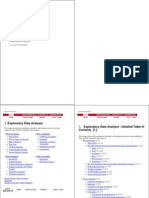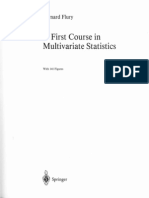Maximum-Likelihood Multiple Quantum Measurements: Analysis
Maximum-Likelihood Multiple Quantum Measurements: Analysis
Uploaded by
thyagosmesmeCopyright:
Available Formats
Maximum-Likelihood Multiple Quantum Measurements: Analysis
Maximum-Likelihood Multiple Quantum Measurements: Analysis
Uploaded by
thyagosmesmeOriginal Description:
Original Title
Copyright
Available Formats
Share this document
Did you find this document useful?
Is this content inappropriate?
Copyright:
Available Formats
Maximum-Likelihood Multiple Quantum Measurements: Analysis
Maximum-Likelihood Multiple Quantum Measurements: Analysis
Uploaded by
thyagosmesmeCopyright:
Available Formats
VOLUME
12 OCTOBER 1992
69
Maximum-Likelihood
NUMBER
Analysis of Multiple Quantum
Samuel L. Braunstein,
Center for Laser Studies, University
15
Phase Measurements
Alistair S. Lane, and Carlton M. Cavestbi
of Southern California, Los Angeles, California 90089 1112(Received 1 June 1992)
&~i
Shapiro, Shepard, and Wong [Phys. Rev. Lett. 62, 2377 (1989)] suggested that a scheme of
multiple phase measurements,
using quantum states with minimum "reciprocal peak likelihood, "
could achieve a phase sensitivity scaling as 1/Nwhere N&oq is the mean number of photons
available for all measurements. We have simulated their scheme for as many as 240 measurements
and havefoundoptimumphasesensitivities
for 3 & Nt t & 120, A power-law fit to thesimulated data
yields a phase sensitivity that scales as 1/N, ', + '
We conclude that reciprocal peak likelihood is
not a good measure of sensitivity.
PACS numbers:
03.65.Bz, 42. 50.Dv, 89.70.+c
Precise determination of small changes in the phase of
light has been an important tool for physics and measurement science for over a hundred years [1] and continues in
that role today [2]. Even with this long history, we have
begun only recently to understand the ultimate bounds
on how efficiently we can measure phase.
For interferometers using coherent states of light, the
Poisson counting statistics produced by the independent
arrivals of photons at the detector yields an optimum
phase sensitivity AC' = 1/2/N&, where Nt is the
mean total number of photons available during the time
the phase to be determined is stable. The 1/2v'N&, & behavior, called the "shot-noise" limit, is not fundamental.
It has been shown experimentally [3] that interferometry with squeezed states can beat the shot-noise limit, as
was predicted theoretically [4]. The optimum sensitivity
for squeezed-state interferometry is believed [5) to scale
as AC
1/N&, with a multiplicative constant of order
unity.
The theoretical basis for handling phase measurements quantum mechanically has generated controversy.
Although there have been many approaches to the
phase [610], a common feature
quantum-mechanical
has been the introduction of a probability distribution
P($~4) for the phase P, which is derived from the quantum state [@c,). Here C, the phase shift to be determined,
can be thought of as a parameter that gives the "location" of ~@g, ) on a phase-space diagram or, more generally, along a curve in Hilbert space. The goal of phase
'.
measurements is to determine C as precisely as possible;
the AC quoted above for interferometric measurements
are precise statements of the statistical confidence in an
experimentally determined value of C.
In order to address fundamental limits on phase measurements, Shapiro, Shepard, and Wong (SSW) [11] (see
also Ref. [12]) assumed and analyzed ideal phase measurements, whose statistics are given by P(Q~C'). The
question of how well we can determine C then reduces to
finding the optimal shape of P(Q~O), given a constraint
on the number of photons. Using their familiarity with
ordinary parameter estimation, SSW sought the quantum state whose phase distribution has the highest peak.
To ensure normalizability, they introduced a cutoff in the
number-state basis and so found a family of states
M
IVc)ssw
= ~)
~inC
. n+1 ~n),
with normalization constant A = ~6/vr + O(M
phase distribution for the SSW state (1) is
M
l)=2 )
(y @)
). The
(2)
These states have a mean photon number
(n)
= 1
determined
6+[p
l+n(M
1+)] /vr
+ O(M ),
solely by the cutoff M, where p
1992 The American Physical Society
(3)
0.57721 is
2153
VOLUME
69, NUMBER 15
PH
YSICAL
R EV I E%'
Euler's constant.
The parameter C gives the location of the peak of the
SSW phase distribution (2). Figure 1 shows examples of
the SSW distribution for small values of (n). For (n) & 2
the distribution takes on a universal shape in the domain
IP
CI 1/M:
A2
Pssw(QI@)
27r
ln(1
)I
(4)
For IP 4I
1/M the photon-number cutoff softens the
logarithmic singularity into a Gaussian peak with height
Pssw(CIC)
= ((n) +1)
/2vrA
For (n) & 2 the picture is that of a universal shape,
consisting of broad tails and a runup to a central peak,
whose height
(n)2 and width
1/M are the only features that depend on (n).
By analogy with the eKciency of maxirnurn-likelihood
(ML) estimation to locate the edge of a rectangular distribution, SSW introduced the "reciprocal peak likelihood, "
LETTERS
12 OC'TOBER 1992
To perform
determine the peak's location accurately.
N measurements,
however, requires N copies of the
SSW state and thus a mean total number of photons
Nt
(n)N. We interpret SSW's proposal as a suggestion that the phase sensitivity of multiple SSW measurements scales as AC
1/Nt2 t.
We investigate this suggestion by performing Monte
Carlo simulations of multiple SSW phase measurements.
"
We assume that N field modes, which we call "pulses,
are prepared in the same SSW state and are shifted in
phase by the same amount C. An ideal phase measurement is performed on each. The measurements yield X
results Pi, . . . , P~ (our N "samples" ), from which we
must estimate the actual phase shift C. Because SSW's
work is based on ML estimation and because ML estimation is optimal asymptotically in N, we use the ML
estimator for C,
CMLE
= arg
. . . , Q~IC),
max
~(C &~ l:(Pi,
where
):
N
bP
sup
7l (C (Vr
2~A2
P(PI 4 )
ssw
(6)
as their measure of phase sensitivity and concluded that
the sensitivity of ideal phase measurements using their
states scales as 1/(mean photon number) 2. A single sampling of Pssw($]4), however, yields almost no information about 4&, because of the broad tails. In contrast,
for mean photon number (n)
1, the phase probability distribution of a coherent state or a squeezed state
is very nearly a Gaussian, with central peak at P = 4
and standard deviation 1/2(n)iiz for a coherent state or
1/(n) for an optimized squeezed state. A Gaussian has
no broad tails, almost all of the probability being concentrated within a few standard deviations of the central
peak; a single sampling provides an estimate of C, which
is good to within a few standard deviations.
SSW argued that many samplings of Pssw(QIO) could
~(41
NivIC'):
Pssw(&i IC')
(8)
This entire process preparing and
phase shifting the pulses, collecting the phase data, and
an idealization
estimating C is a single "experiment"
of a multiple-measurement
laboratory experiment. The
ultimate result of an experiment is a single number, the
ML estimate C MLE.
An experimenter wants to know how much confidence
should be placed in the estimate @Mr,E. Thus we seek to
determine the probability distribution P(4MLE]4) of the
ML estimator, given an actual phase shift C. This "estimator distribution" contains all statistical information
about the estimator. To summarize important information in a single number, we give the one-sided 68.26'%%uo
confidence interval (AC)ss% defined by saying that the
estimator has a 68.26%%uo probability to lie within an interval of width 2(AC)as% which brackets symmetrically
the actual phase shift C. Such a confidence interval is
unquestionably a good measure of phase sensitivity. We
use the one-sided 68.26'%%uo confidence interval because it
corresponds to 1 standard deviation of a Gaussian.
The asymptotic behavior of ML estimation is known
oo the estimator
from Fisher's theorem [13]: As N
distribution approaches a Gaussian with standard deviation
is the log-likelihood.
AC
z/2
Tt/2
FIG. 1. SSW distribution Pssw($]4), with peak at 4 = 0
and with mean photon numbers (n) = 0.56 (dotted line), 1.02
(dashed line), and 2.00 (solid line).
2154
= 1/QNF
Here F, the Fisher information [13], is determined by
the phase distribution. For the SSW distribution, F is a
function only of (n) (or M) and increases roughly linearly
with M. ML estimation is also asymptotically eKcient:
The Cramer-Rao lower bound [13] states that for a very
broad class of estimation techniques, AO & 1/QNF for
VOl UME
PH YSICAL REVIEW
69, NUMBER 15
10
20
LETTERS
12 OCTOBER 1992
50 100 200
0.5
10
20
50
100
0.5
0.2
0.2
0. 1
Q
0. 1
Q5
CI
o.os
0.02
0.01
0.02
FIG. 2. Log-log plot of 68%%uo confidence intervals (DC)es%
of pulses N for SSW states with
(n) = 2.00 (error bars represent 95'%%uo confidence in the plotted confidence intervals). The dashed line gives the (NF)
Cramer-Rao lower bound on the standard deviation DC of
any estimator, with the Fisher information F calculated for
(n) = 2.00.
(in radians)
vs number
all sample sizes
Monte Carlo simulation proceeds by doing a sufFicient
number of experiments for particular values of (n) and
N to map out the estimator distribution P(CMi, E~O) for
those values. Since the simulations are demanding of
computer time, we have only been able to do a sufficient
number of numerical experiments for representative values in the range (n) & 5, N & 240, and Nt, t & 480.
Figure 2 shows the convergence of the 68% confidence
interval with increasing numbers of pulses N for the SSW
state with (n) = 2.00. For N & 3 the ML estimator
distribution P(@Mi,E~0) is so wide that it is sensitive to
the finite 2vr range of phases. At the other extreme, for
N 50 the asymptotic I/y'NF behavior of Fisher's theorem takes over as the confidence intervals become small
enough to probe the 1/M width of the central peak. Between these two regions lies a region of "universal convergence, " where ML estimation is unable to "see" the
narrow central peak. In this region the confidence intervals are determined by the universal shape of the SSW
distribution, and hence the convergence of the confidence
intervals must follow some universal form independent of
(n). Unfortunately, we have been unable to discover the
scale-invariant shape that characterizes this preasymptotic universal convergence. A power-law Gt to our data
for (n) = 3, 4, and 5, with 3 & N & 40 all of which data
are comfortably within the preasymptotic region yields
a 1/Ni is scaling for the preasymptotic 68% confidence
intervals.
The universal convergence in the preasymptotic region
is easier to see in Fig. 3, where we plot 68% confidence intervals for selected values of Nt- t. Points with the same
Nt t, are joined by straight line segments.
By following the confidence intervals with Nt t fixed, we can see
the effect of changing the split between the number of
FIG. 3. Log-log plot of 68'%%uo confidence intervals (AO)6s%
(in radians) vs number of pulses N for selected values of Nial, .
Error bars are suppressed, and points with the same Nt t are
joined by line segments. For each N&, t, there is an optimum
number of pulses which gives the best phase sensitivity.
pulses, N, and the mean number of photons per pulse,
(n). As we split up the photon-number resources into
pulses, the preasymptotic universal convergence gives initially an improvement in the 68% confidence intervals,
until they approach the Cramer-Rao lower bound. Then
the curves turn up into the asymptotic I/QNF behavior of Fisher's theorem, which here has an upward slope
because Nt, t is fixed. The optimal split occurs at the
"knee" between the preasymptotic universal convergence
and Fisher's asymptotic behavior.
Figure 4 plots the optimized 68'%%uo confidence intervals, obtained by using the optimal split of resources
from Fig. 3, against the mean total number of photons
available, i.e. , against the constrained quantity Nt t. A
straight-line fit yields
I/NQ. s5+0.01
(gC, )
for the optimized 68% confidence intervals over the range
0.5
10
20
50
100
0.2
0. 1
o.os
0.02-
FIG. 4. Log-log plot of optimized 68% confidence intervals
(EC)6s% (in radians; optimum number of pulses from Fig. 3)
vs mean total number of photons Ni, i (error bars represent
95% confidence in the plotted confidence intervals). The bestfit line corresponds to (AC)es% = 0.97N, ,
2155
VOLUME
69, NUMBER 15
PH
YSICAL
R EV I EW
Nt- t
120 that is accessible to our simulations.
3
Over this range the convergence rate of confidence intervals, obtained from ML estimation, is significantly slower
than the 1/N2 ~ scaling which SSW extracted from the
We conclude that reciproreciprocal peak likelihood.
cal peak likelihood is not a good measure of sensitivity.
Others [1416] have argued that reciprocal peak likelihood is not a good measure of phase sensitivity, but our
work, by finding the sensitivity of multiple SSW measurements, demonstrates the inadequacy of reciprocal peak
likelihood. Furthermore, over the range of our simulations, we find that multiple SSW measurements do not
have a phase sensitivity as good as the I/Nt, scaling of
squeezed-state interferometry.
The relevant scale in the SSW distribution is the
2
("lis. This width is excentral-peak width 1/M
e
ponentially small in (n) [14], but many pulses are required to locate the central peak with an accuracy approaching the width, because of the small probability
(n)z/M
(lnM) /M under the peak. Indeed, the
central-peak width is, crudely speaking, the phase sensitivity at the knee transition from preasymptotic universal
convergence to asymptotic Fisher behavior.
Optimal SSW measurements for a fixed Nt require
many pulses X with only a few mean photons per pulse,
(n). This behavior should be contrasted with that for
coherent states and squeezed states, for which the nearGaussian phase distribution means that the sensitivity
of multiple measurements using ML estimation improves
as I/~N. For coherent states, with phase standard desensitivity
viation I/2(n) i2, the multiple-measurement
~
=
of
how the
is
independent
I/2y'N&
I/2((n)N)
photon-number
resources are split between the number
of pulses and the number of photons per pulse. For optimized squeezed states, with standard deviation
I/(n),
the optimum sensitivity is attained by using a single pulse
that carries all the photons.
convergence rate
The large-Nq, t confidence-interval
cannot be obtained directly from our simulations. If the
form of the preasymptotic universal convergence were
known, then its approach to the I/QNF Cramer-Rao
lower bound for a particular (n) would give us the optimum number of pulses for that (n); extrapolations based
on various assumptions for the universal convergence will
be discussed elsewhere [17]. Alternatively, working backwards from a knowledge of where the asymptotic Gaussian approximation to the ML estimator breaks down [18]
behavior
can give a direct way to attack the large-Nt
[17, 19].
We do not know at present how to formulate the general question of quantum limits on phase sensitivity, because it becomes entangled in dificult issues of estima&
t-,
2156
LETTERS
12 OcToBFR 1992
tion theory for multiple measurements. Nonetheless, our
work shows that there are surprises lurking in multiplemeasurement schemes
we did not expect SSW states to
achieve even the shot-noise limit and it indicates that
any investigation of the ultimate phase sensitivity must
allow for a "divide-and-conquer" strategy that divides up
the available photons among many measurements of the
same phase datum.
This work was supported in part by the Once of Naval
Research (Contract No. N00014-88-K-0042 and Grant
No. N00014-91- J-1167). S.L.B. appreciated the support
of the Lady Davis Fellowship Trust in writing up this
work, and he thanks A. Mann for a critical reading of
the manuscript.
Present address: Department of Physics, Technion Israel
Institute of Technology, 32 000 Haifa, Israel.
Present address: Department of Physics and Astronomy, University of New Mexico, Albuquerque, NM 87131-
1156.
[1] A. A. Michelson and
E. W.
Morley, Am.
J. Sci. 84, 333
(1887) .
[2] See, for example, A. Abramovici
et al. , Science
256, 325
(1992).
L.-A. Wu, and H. J. Kimble, Phys. Rev. Lett.
59, 278 (1987).
C. M. Caves, Phys. Rev. D 23, 1693 (1981).
B. Yurke, S. L. McCall, and J. R. Klauder, Phys. Rev. A
88, 4033 (1986).
L. Susskind and J. Glogower, Physics (Long Island City,
N. Y.) 1, 49 (1964).
P. Carruthers and M. M. Nieto, Rev. Mod. Phys. 40, 411
(1968).
J.-M. Levy-Leblond, Ann. Phys. (N. Y.) 101, 319 (1976).
D. T. Pegg and S. M. Barnett, Phys. Rev. A 39, 1665
[3] M. Xiao,
[4]
[5
[6]
[7]
[8]
[9]
(1989).
[10 S. M. Barnett and D. T. Pegg, J. Mod. Opt. 86, 7 (1989).
[11 J. H. Shapiro, S. R. Shepard, and N. W. Wong, Phys.
Rev. Lett. 62, 2377 (1989) (cited in text as SSW).
[12] J. H. Shapiro and S. R. Shepard, Phys. Rev. A 43, 3795
(1991).
[13] H. Cramer, Mathematical Methods of Statistics (Princeton Univ. Press, Princeton, NJ, 1946), esp. pp. 500504.
[14] W. P. Schleich, J. P. Dowling, and R. J. Horowicz, Phys.
Rev. A 44, 3365 (1991).
[15 Z. Hradil and J. H. Shapiro, Quantum Opt. 4, 31 (1992).
[16 M. J. W. Hall (to be published).
[17 A. S. Lane, S. L. Braunstein, and C. M. Caves (to be
published) .
[18] S. L. Braunstein, J. Phys. A 25, 1 (1992).
[19] S. L. Braunstein (to be published).
You might also like
- Machine Learning Fundamentals A Concise Introduction by Hui JiangDocument423 pagesMachine Learning Fundamentals A Concise Introduction by Hui JiangJorge MoraesNo ratings yet
- Casella Berger Statistical InferenceDocument686 pagesCasella Berger Statistical Inferencethyagosmesme50% (2)
- A Passive Localization Algorithm and Its AccuracyDocument12 pagesA Passive Localization Algorithm and Its AccuracyJi Hau CherngNo ratings yet
- Finding Stationary Subspaces in Multivariate Time Series: Week Ending 20 NOVEMBER 2009Document4 pagesFinding Stationary Subspaces in Multivariate Time Series: Week Ending 20 NOVEMBER 2009Anonymous 4v9XurwNo ratings yet
- Skenderovic JQSRTDocument8 pagesSkenderovic JQSRTSrdjan FilipovićNo ratings yet
- ANALYSIS OF CLUTTER CANCELLATION IN THE PRESENCE OF MEASURED L-BAND RADAR GROUND CLUTTER DATADocument6 pagesANALYSIS OF CLUTTER CANCELLATION IN THE PRESENCE OF MEASURED L-BAND RADAR GROUND CLUTTER DATArafik trabelsiNo ratings yet
- 10 3 3Document5 pages10 3 3jin.austronNo ratings yet
- Cumulant Correlators From The APMDocument10 pagesCumulant Correlators From The APMSugumar Sar DuraiNo ratings yet
- Large N Phase Transitions in Supersymmetric Chern-Simons Theory With Massive MatterDocument16 pagesLarge N Phase Transitions in Supersymmetric Chern-Simons Theory With Massive MattertttottoNo ratings yet
- On Errors of Fit and Accuracy in Matching Synthetic Seismograms and Seismic TracesDocument21 pagesOn Errors of Fit and Accuracy in Matching Synthetic Seismograms and Seismic TracesBSSNo ratings yet
- Quantum State Tomography Via Linear Regression Estimation: Scientific ReportsDocument6 pagesQuantum State Tomography Via Linear Regression Estimation: Scientific ReportsYang YiNo ratings yet
- Uniform-Hazard Response Spectra-An Alternative ApproachDocument13 pagesUniform-Hazard Response Spectra-An Alternative ApproachSoheil RamezaniNo ratings yet
- Lab4_ErrorAnalysisII (1)Document8 pagesLab4_ErrorAnalysisII (1)yugshah180No ratings yet
- On The Chances of Being Struck by Cloud-to-Ground Lightning: KriderDocument4 pagesOn The Chances of Being Struck by Cloud-to-Ground Lightning: KriderItalo ChiarellaNo ratings yet
- 1984bssa Avg RadpatsDocument7 pages1984bssa Avg RadpatsValentina Pavez GutiérrezNo ratings yet
- ), and R: O 5 To Is 20 Signo! Lo NoiseDocument2 pages), and R: O 5 To Is 20 Signo! Lo NoiseSugunaNo ratings yet
- October: Evidence Neutrino Instability PasierbDocument5 pagesOctober: Evidence Neutrino Instability PasierbBorislav_Nedel_8286No ratings yet
- A CFAR Adaptive MatchedDocument9 pagesA CFAR Adaptive Matchedرضا البراءNo ratings yet
- 1978 - Jelínek-Kropáček1978 Article StatisticalProcessingOfAnisotrDocument13 pages1978 - Jelínek-Kropáček1978 Article StatisticalProcessingOfAnisotrluis velderrain RojasNo ratings yet
- Global Wilson-Fisher Fixed PointsDocument28 pagesGlobal Wilson-Fisher Fixed PointsCroco AliNo ratings yet
- Theory of Uncertainty of Measurement PDFDocument14 pagesTheory of Uncertainty of Measurement PDFLong Nguyễn VănNo ratings yet
- Cs ImagingDocument13 pagesCs ImagingRoronoaNo ratings yet
- A Closed-Form Method For Finding Source Locations From Microphone-Array Time-Delay EstimatesDocument4 pagesA Closed-Form Method For Finding Source Locations From Microphone-Array Time-Delay Estimatesscribd1235207No ratings yet
- Topic Determination of Source Parameters From Seismic SpectraDocument7 pagesTopic Determination of Source Parameters From Seismic SpectraFrancisco JavierNo ratings yet
- Nuclear Counting StatisticsDocument18 pagesNuclear Counting Statisticsjeff_hammonds351No ratings yet
- 1991 - The Determination of The Seismic Quality Factor Q From VSP Data - A Comparison of Different Computational Methods - TonnDocument27 pages1991 - The Determination of The Seismic Quality Factor Q From VSP Data - A Comparison of Different Computational Methods - TonnJimmy Johan Tapia VásquezNo ratings yet
- Circular Data AnalysisDocument29 pagesCircular Data AnalysisBenthosmanNo ratings yet
- James R. Henderson Et Al - Calculated Ro-Vibrationai Spectrum of 7-Li3 + and 7-Li2 6li +Document4 pagesJames R. Henderson Et Al - Calculated Ro-Vibrationai Spectrum of 7-Li3 + and 7-Li2 6li +TreaxmeANo ratings yet
- Confidence Interval Non NormalityDocument15 pagesConfidence Interval Non NormalityMaciej OchocińskiNo ratings yet
- Statistics ReviewDocument16 pagesStatistics ReviewAlan BatschauerNo ratings yet
- (Kesten, 1986) The Incipient Infinite Cluster in Two-Dimensional PercolationDocument26 pages(Kesten, 1986) The Incipient Infinite Cluster in Two-Dimensional PercolationFardad PouranNo ratings yet
- Performance Analysis of Energy Detection-Based Spectrum Sensing Over Fading ChannelsDocument4 pagesPerformance Analysis of Energy Detection-Based Spectrum Sensing Over Fading ChannelsMary VargasNo ratings yet
- The Statistical Distribution of The Maxima of A Random Function by Cartwright and Longuet HigginsDocument22 pagesThe Statistical Distribution of The Maxima of A Random Function by Cartwright and Longuet Higginsadaniliu13No ratings yet
- Statistics of Paleomagnetic Data: Paleomagnetism: Chapter 6 103Document18 pagesStatistics of Paleomagnetic Data: Paleomagnetism: Chapter 6 103PARTHA SARATHI PALNo ratings yet
- Rayleigh Fading 39 CitationsDocument25 pagesRayleigh Fading 39 Citationscharu dattaNo ratings yet
- Affine Invariant Edge Maps and Active ContoursDocument26 pagesAffine Invariant Edge Maps and Active Contoursaqsahussain272No ratings yet
- A Clutter Suppression Method Based On Angle-Doppler Compensation For Airborne Radar With Uniform Circular Arrays AntennasDocument4 pagesA Clutter Suppression Method Based On Angle-Doppler Compensation For Airborne Radar With Uniform Circular Arrays Antennassathish14singhNo ratings yet
- Image Quality Assessment and Statistical Evaluation: February 4, 2005Document25 pagesImage Quality Assessment and Statistical Evaluation: February 4, 2005karedokNo ratings yet
- Deterministic Phase Retrieval: A Green's Function SolutionDocument8 pagesDeterministic Phase Retrieval: A Green's Function Solutionlednakashim100% (1)
- Frequency-Radial Duality Based Photoacoustic ReconstructionDocument3 pagesFrequency-Radial Duality Based Photoacoustic ReconstructionS.M. Akramus SalehinNo ratings yet
- MIT6 453F16 Lect1 Notes PDFDocument14 pagesMIT6 453F16 Lect1 Notes PDFzaina0cassNo ratings yet
- 2401.02553v2Document4 pages2401.02553v2msmonster8989No ratings yet
- Calculate Frequencies in G09Document20 pagesCalculate Frequencies in G09Axel Velasco ChávezNo ratings yet
- BCE - Technical - Note - 3 - Relating Peak Particle Velocity and Acceleration To Moment Magnitude in Pasive Seismic MonitoringDocument5 pagesBCE - Technical - Note - 3 - Relating Peak Particle Velocity and Acceleration To Moment Magnitude in Pasive Seismic MonitoringTony ChanNo ratings yet
- KrigingDocument20 pagesKrigingDeepblue09No ratings yet
- Wolfgang Hasse and Volker Perlick - Gravitational Lensing in Spherically Symmetric Static Spacetimes With Centrifugal Force ReversalDocument18 pagesWolfgang Hasse and Volker Perlick - Gravitational Lensing in Spherically Symmetric Static Spacetimes With Centrifugal Force ReversalKunma050No ratings yet
- Ballistic Missile Track Initiation From Satellite ObservationsDocument18 pagesBallistic Missile Track Initiation From Satellite ObservationsGiri PrasadNo ratings yet
- Small Sample Size Performance of The Energy DetectorDocument4 pagesSmall Sample Size Performance of The Energy Detectorsuchi87No ratings yet
- Broadband Source Angle Estimation Using: A Sparse Uniform Linear Acoustic ArrayDocument6 pagesBroadband Source Angle Estimation Using: A Sparse Uniform Linear Acoustic Arrayscribd1235207No ratings yet
- Well To Seismic Calibration: A Multiwell Analysis To Extract One Single WaveletDocument4 pagesWell To Seismic Calibration: A Multiwell Analysis To Extract One Single WaveletjoeregueNo ratings yet
- Vibronic Spectra G09-A02 PDFDocument20 pagesVibronic Spectra G09-A02 PDFSameer EdirisingheNo ratings yet
- Energy Detectiion of Unknown Deterministic Signals by Harry UrkowitzDocument9 pagesEnergy Detectiion of Unknown Deterministic Signals by Harry UrkowitzZARGHAM KHANNo ratings yet
- A Signal Processing Method For Circular Arrays: John D. HenstridgeDocument6 pagesA Signal Processing Method For Circular Arrays: John D. HenstridgeAS LCNo ratings yet
- A Comparison of Spatial Interpolation Methods Azpurua & DosRamos 2010 PDFDocument11 pagesA Comparison of Spatial Interpolation Methods Azpurua & DosRamos 2010 PDFLeomaris Perales ContrerasNo ratings yet
- 10.1515 - Astro 2000 0312Document12 pages10.1515 - Astro 2000 0312mohamedaziz.bechNo ratings yet
- Harmonic Maps and Minimal Immersions with Symmetries: Methods of Ordinary Differential Equations Applied to Elliptic Variational ProblemsFrom EverandHarmonic Maps and Minimal Immersions with Symmetries: Methods of Ordinary Differential Equations Applied to Elliptic Variational ProblemsNo ratings yet
- Classification With Rejection Concepts and EvaluationsDocument13 pagesClassification With Rejection Concepts and EvaluationsthyagosmesmeNo ratings yet
- IEEE Xplore Full-Text PDFDocument1 pageIEEE Xplore Full-Text PDFthyagosmesmeNo ratings yet
- Mathematics: Least-Squares Estimators of Drift Parameter For Discretely Observed Fractional Ornstein-Uhlenbeck ProcessesDocument20 pagesMathematics: Least-Squares Estimators of Drift Parameter For Discretely Observed Fractional Ornstein-Uhlenbeck ProcessesthyagosmesmeNo ratings yet
- Bootstrap 1Document16 pagesBootstrap 1thyagosmesmeNo ratings yet
- TWO Estimated Snow Load Curves AND THE Bootstrap Significance TestDocument15 pagesTWO Estimated Snow Load Curves AND THE Bootstrap Significance TestthyagosmesmeNo ratings yet
- Fa TheoryDocument17 pagesFa TheorythyagosmesmeNo ratings yet
- Take Profit and Stop Loss Trading Strategies Comparison in Combination With An MACD Trading SystemDocument23 pagesTake Profit and Stop Loss Trading Strategies Comparison in Combination With An MACD Trading SystemthyagosmesmeNo ratings yet
- Lecture 20: Model Adaptation: Machine Learning April 15, 2010Document35 pagesLecture 20: Model Adaptation: Machine Learning April 15, 2010thyagosmesmeNo ratings yet
- Deep Learning For Financial Time Series Forecasting in A-TraderDocument8 pagesDeep Learning For Financial Time Series Forecasting in A-TraderthyagosmesmeNo ratings yet
- How To Spot Backtest Overfitting: Lawrence Berkeley National Lab (Retired), and University of California, DavisDocument15 pagesHow To Spot Backtest Overfitting: Lawrence Berkeley National Lab (Retired), and University of California, DavisthyagosmesmeNo ratings yet
- Machine Learning For Stock SelectionDocument19 pagesMachine Learning For Stock SelectionthyagosmesmeNo ratings yet
- Front-End Factor Analysis For Speaker VerificationDocument12 pagesFront-End Factor Analysis For Speaker VerificationthyagosmesmeNo ratings yet
- Algorithms For Portfolio Management Based On The Newton MethodDocument8 pagesAlgorithms For Portfolio Management Based On The Newton MethodthyagosmesmeNo ratings yet
- Bootstrapping Time Series ModelsDocument43 pagesBootstrapping Time Series ModelsthyagosmesmeNo ratings yet
- Yale PDFDocument6 pagesYale PDFthyagosmesmeNo ratings yet
- Moskowitz Time Series Momentum PaperDocument23 pagesMoskowitz Time Series Momentum PaperthyagosmesmeNo ratings yet
- 2000 ConfDocument22 pages2000 ConfthyagosmesmeNo ratings yet
- Materiales de Referencia CCRMP (CANMET)Document5 pagesMateriales de Referencia CCRMP (CANMET)Erick Leonardo Valle MendozaNo ratings yet
- MDM4U 4-5 SummativeDocument5 pagesMDM4U 4-5 Summativecaviarsucks44No ratings yet
- MT+BBA+ATA+502+QP+101224Document5 pagesMT+BBA+ATA+502+QP+101224Amlyan MukherjeeNo ratings yet
- Two Samples Z-TestDocument14 pagesTwo Samples Z-TestStalin ArmijosNo ratings yet
- Sta 1302Document2 pagesSta 1302cfadennisoduolNo ratings yet
- Pearson and CorrelationDocument8 pagesPearson and CorrelationEunice OrtileNo ratings yet
- Continuous Random Variables and Their Probability DistributionsDocument59 pagesContinuous Random Variables and Their Probability DistributionsAniruddha Bhatta PGP 2022-24 BatchNo ratings yet
- MAT 3103: Computational Statistics and Probability Chapter 8: SamplingDocument14 pagesMAT 3103: Computational Statistics and Probability Chapter 8: SamplingShahariar KabirNo ratings yet
- Engineering Statistics Handbook 2003Document1,522 pagesEngineering Statistics Handbook 2003d-fbuser-67904250No ratings yet
- EDA - Ciclo2022 - 2 - EstadisticaByvariadaDocument9 pagesEDA - Ciclo2022 - 2 - EstadisticaByvariadaRicardo CremaNo ratings yet
- PS1 QuestionsDocument5 pagesPS1 QuestionsYasemin YücebilgenNo ratings yet
- Newbold Sbe8 Ch02 GeDocument65 pagesNewbold Sbe8 Ch02 GeGemma SteveNo ratings yet
- 2 StatisticsDocument52 pages2 Statisticsbing zhuoNo ratings yet
- 410Hw02 PDFDocument3 pages410Hw02 PDFdNo ratings yet
- 7Document22 pages7farihafairuzNo ratings yet
- S2-WST02 01 Que 20180626Document24 pagesS2-WST02 01 Que 20180626Xavier JiangNo ratings yet
- Schools Division Office of Camarines Sur Learning Activity Sheet No. 12Document6 pagesSchools Division Office of Camarines Sur Learning Activity Sheet No. 12Gil Barry Nacario OrdoñezNo ratings yet
- kol1_pc_2019_rozwDocument10 pageskol1_pc_2019_rozw9ntallNo ratings yet
- 3.3.4 Mean and Variance of The Sampling Distribution of The Sample MeansDocument3 pages3.3.4 Mean and Variance of The Sampling Distribution of The Sample MeansJhasmin Jane LagamayoNo ratings yet
- Probability-Danna Angeline Santos SantosDocument1 pageProbability-Danna Angeline Santos SantosDANNA ANGELINE SANTOS SANTOSNo ratings yet
- Student T-Distribution TableDocument1 pageStudent T-Distribution Tablenorman50% (2)
- Topic 7 Linear Regreation CHP14Document21 pagesTopic 7 Linear Regreation CHP14Natasha Mgt JoharNo ratings yet
- Part 2 Descriptive StatisticsDocument47 pagesPart 2 Descriptive Statisticscarla guban-oñes100% (1)
- The Expected Value and Variance of A Discrete Random VariableDocument14 pagesThe Expected Value and Variance of A Discrete Random VariableLiana Putri MaharaniNo ratings yet
- 22-Lecture Notes On Probability Theory and Random ProcessesDocument302 pages22-Lecture Notes On Probability Theory and Random ProcessesAshish Sachan100% (1)
- Inventory Management II PPT 16-18Document16 pagesInventory Management II PPT 16-18Prateek KonvictedNo ratings yet
- A First Course in Multivariate Statistics: Bernard FluryDocument4 pagesA First Course in Multivariate Statistics: Bernard FluryAlonso Maximiliano Molina NúñezNo ratings yet
- 3.3 Notes: Correlations - The Strength of A Linear Trend: ObjectivesDocument15 pages3.3 Notes: Correlations - The Strength of A Linear Trend: ObjectivesKatieNo ratings yet
- This Study Resource Was: Katelyn Wnek 3/25/2021 Generalizability AssignmentDocument3 pagesThis Study Resource Was: Katelyn Wnek 3/25/2021 Generalizability AssignmentAngra ArdanaNo ratings yet








